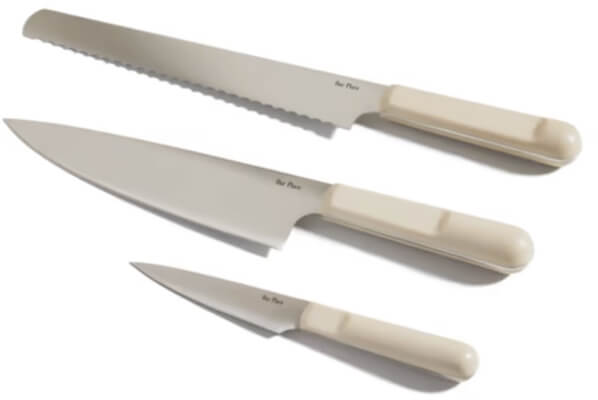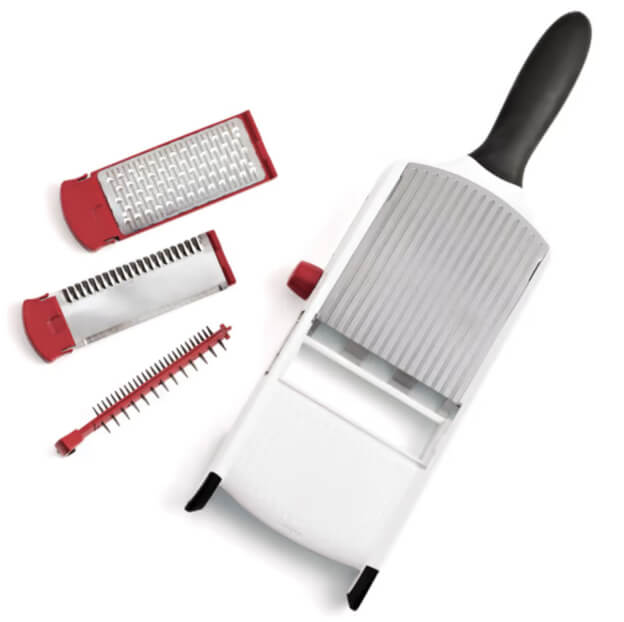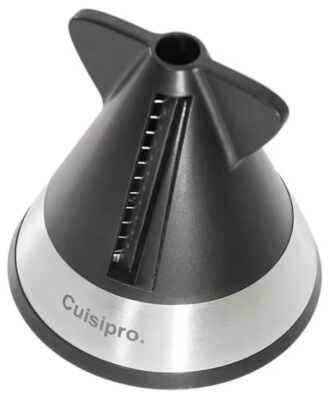
Photo courtesy of Olivia Muniak
How and When to Use Different
Knives, Slicers, and Graters
Caitlin O’Malley is goop’s food director. Her passions include coffee in the park, snack board lunches, her cat, and kitchen tools. In this series, she shares her most beloved gadgets—the luxe, the lo-fi, and the utilitarian—and all the wonderful things they’ll help you do.
I’m hardly a minimalist, but I do try to avoid gadgets that perform only one task. And sure, there will always be exceptions—I have a deep affection for my pasta maker, musubi mold, proofing baskets, and Whirley-Pop. But as my cabinet space becomes increasingly limited, I’ve come to prefer the tools that multitask.
The slicing-and-dicing category is perhaps the worst offender of single-task tools. There are a million gizmos designed to cut particular foods—eggs, mangos, apples, garlic. I was once gifted a little leaf-shaped piece of plastic specifically designed to rip the leaves off woody herbs. If those gadgets spark joy, then by all means, use and enjoy them! But they’re far from essential. In my kitchen, I keep a simplified lineup that gets almost every imaginable job done.
KNIVES
If austerity is your style and your knife skills are up to snuff, you can easily get away with having just a good three-piece knife set in your arsenal. Many sets come with more, but three is all you really need. A chef’s knife is your all-purpose knife that you’ll use the most—chopping broccoli, cutting up a watermelon, carving a chicken—you can even use the side of the knife to smash garlic cloves, then cook them whole or mince them into a paste. A serrated knife is essential for things like bread and tomatoes: The teeth of the knife cut through tougher exteriors without squishing the tender interiors. Small paring knives are great for nimble work like peeling and small jobs like hulling strawberries or cutting lime wedges for cocktails.
GRATER
The Microplane grater is one of my all-time favorite tools. Its smart design and ease of use have made it essential in professional kitchens, and it has many applications for the home cook, too. I probably use it most for grating garlic—it becomes a smooth paste, allowing that savory pungency to be distributed throughout your marinade or dressing without you worrying about biting into a spicy chunk of raw garlic. Zesting citrus with it is a dream—I prefer to hold the fruit in my nondominant hand while I move the grater all around it so I can see where and when I’ve hit the bitter white pith. Other ingredients that are great to grate: hard cheeses, ginger, whole nutmeg and cinnamon, salt-cured egg yolk, bottarga, lemongrass, horseradish, and chocolate.
MANDOLINE
The mandoline is an intimidating tool—and rightly so. The first time I worked in a restaurant kitchen, the chef told me, “When you’re on the mandoline, you’re on the mandoline.” Meaning no chitchat, no multitasking, no distractions whatsoever. If you aren’t paying attention, it’s very easy to give yourself a nasty cut. But, if you are able to be a little brave (and a lot mindful), you will find the results are worth the effort.
The mandoline will give you beautiful, uniform slices and can be manually adjusted to get thicker or thinner slices. Not only is this aesthetically pleasing, but it has some significant functional effects on your cooking, too. For one, having things cut in uniformity
gives a very pleasant texture and mouthfeel—think of a cool and crunchy slaw where the shredded cabbage and carrots are the same length and thickness. It makes for the most satisfying bite. The other upside is that uniformity means even cooking. If the veggies in this moo shu recipe are all cut thinly and evenly, they will cook quickly and evenly. You can, of course, do all this by hand, but the mandoline makes it such a fast and easy job and gives the kind of precision that takes years of practice to perfect if relying on knife skills alone.
Use a safety guard (they often come included) or a cut-resistant glove while you start out and get used to the mandoline. My other piece of advice is to be okay with a little waste—every time I’ve cut myself using a mandoline, it was in an attempt to get one more slice out of a cucumber or radish. Play it safe, cut your losses, and enjoy the scrap as a snack instead.
FOOD PROCESSOR
A food processor is a brilliant multitasking tool. I went without one for years, and now that I have a food processor, I can’t go back. It’s wonderful for making hummus, banana “nice” cream, pie dough—but in terms of the slicing-and-dicing realm, it’s the pulsing feature that’s most useful.
Manually pulsing a food processor lets the blades run in short, quick bursts. This allows you to have lots of control and to visually gauge just how chopped you want your ingredients to be. The only potential downside is that you won’t get that refined, perfectly neat texture, which is why I save this feature for unfussy jobs, like chopping veggies for a mirepoix or sofrito that gets cooked down and mixed with a sauce or soup. You’ll be able to cut a couple of onions, carrots, and cloves of garlic in a fraction of the time it would take to chop by hand.
The other things I regularly make with my food processor are cauliflower rice (popping in florets and pulsing until I get the texture I like) and small chunks of parmesan cheese. After I blitz the cheese for a while, it turns out so light and airy, perfect for that snowlike sprinkle on top of pasta and salads.
SPIRALIZER
Okay, so this might not be essential to everyone, but if you don’t eat grains or just like to make veggie noodles, you’ll definitely want to have a spiralizer on hand. Some spiralizers are bulky and complicated with lots of attachments, but I prefer the straightforward handheld ones. They’re small, low-tech (in a good way), simple to use, and, most importantly, easy to clean—think of them as giant pencil sharpeners. The long, twisty noodles can be used for grain-free pasta, curly fries, and veggie fritters, but my favorite is adding them to salads. The texture is so pleasing.
Want to Learn More about Kitchen Tools?
-
Ever wonder how you’re really supposed to clean that cast-iron pan? Or what the deal is with high-heat cooking on nonstick pans? Our guide to cooking with and caring for cookware will come in handy.
-
Because we always need more easy cooking inspo, we took a deep dive into the ultimate weeknight dinner hero: the sheet pan.
-
Here’s why Dutch ovens are a worthy investment and deserve a place in your kitchen.
-
All your coffee gear and brewing questions answered, plus our favorite beans and recipes to enjoy with your brew.







